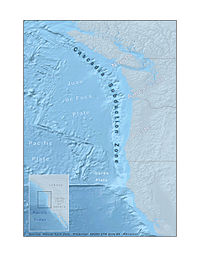
Photo from wikipedia
ABSTRACT The Pelona–Orocopia–Rand and related schists of southern California are an archetypal example of an exhumed shallow subduction complex. ‘The schist’ comprises mainly trench materials underthust beneath continental arc rocks… Click to show full abstract
ABSTRACT The Pelona–Orocopia–Rand and related schists of southern California are an archetypal example of an exhumed shallow subduction complex. ‘The schist’ comprises mainly trench materials underthust beneath continental arc rocks during Late Cretaceous–early Cenozoic collision of one or more oceanic plateaux with southern California. The arc-on-trench relationship, without intervening mantle or lowermost crust, implies that significant subduction erosion accompanied shallow subduction. Upsection increases in metamorphic grade (~150 ± 100°C/km) and spatial variations in age and peak temperature provide an ~50 million year long record of tectonic underplating within a cooling system. Evidence for palaeoseismic events in earliest formed and hottest (locally transitional granulite grade) schists provides a possible field-based record of episodic tremor and slow slip events such as detected in several modern shallow subduction zones. Structural ascent of the schist was achieved in distinct Late Cretaceous–early Eocene and late Oligocene–early Miocene extensional pulses, the first during collapse of gravitationally unstable upper plate assemblages and accompanied by trench-directed (top-NE) lower plate extrusion and the second corresponding temporally, spatially, and in character with core complex formation in the SW United States. The line between schist and core complex belts is blurred by the recent discovery of schist within 40 km of the nearest core complex and containing synkinematic Miocene intrusions, a hallmark of SW U.S. core complexes. The history of schist assembly, metamorphism, and exhumation provides the most complete field-based record of thermo-mechanical processes, subduction erosion and tectonic underplating in particular, that operated during a shallow subduction event. Future cross-disciplinary investigations of, and comparisons between, the schist and other possible ancient (e.g. Swakane gneiss, Sanbagawa belt, Qiangtang terrane) and modern (e.g. Cascadia, SW Japan, central Mexico, Chile) shallow subduction zones will yield new insights into the tectonic and petrologic processes that operate within such systems.
Journal Title: International Geology Review
Year Published: 2017
Link to full text (if available)
Share on Social Media: Sign Up to like & get
recommendations!